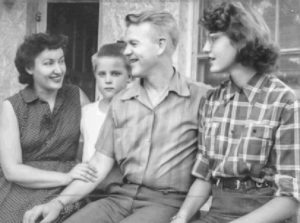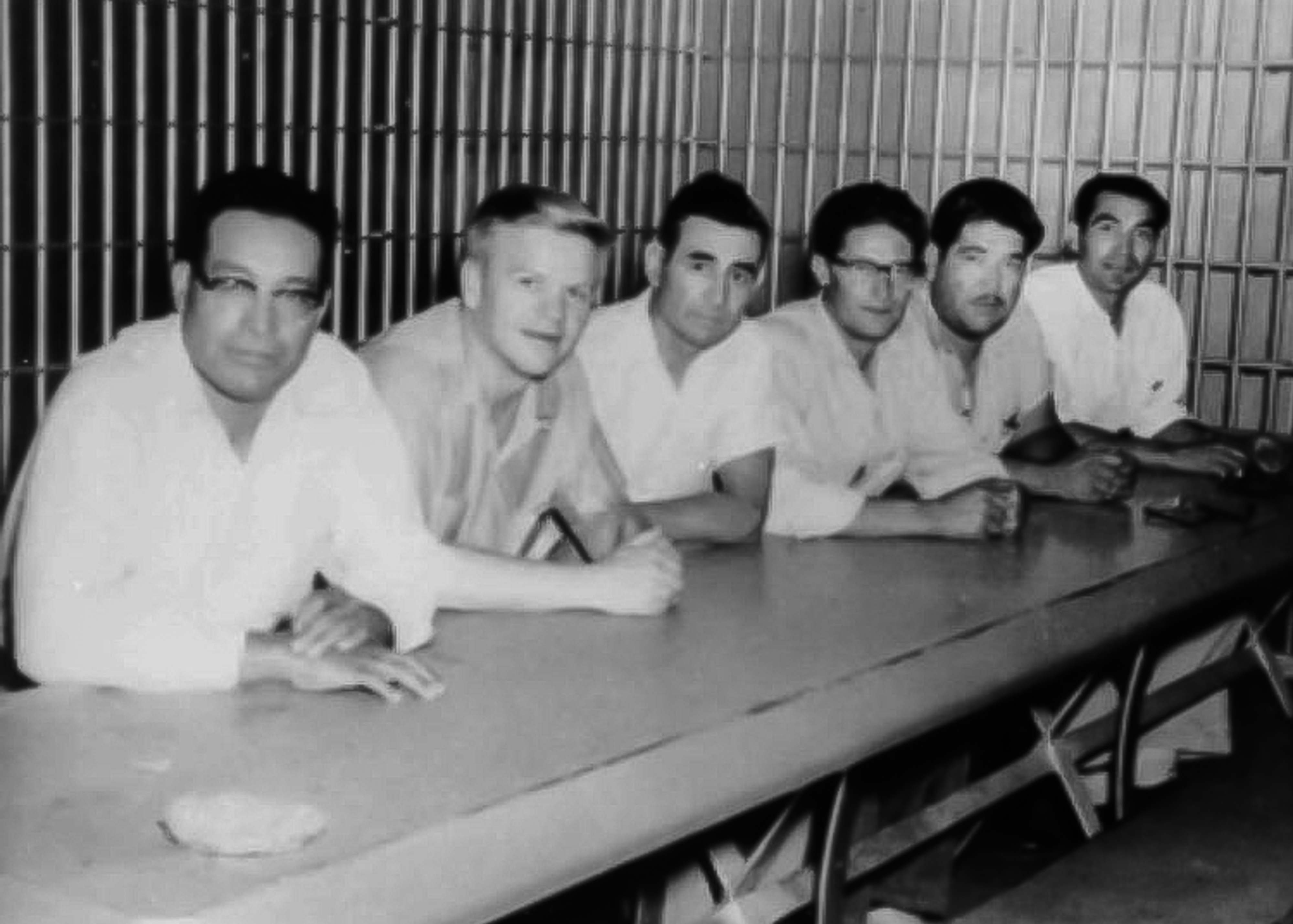They called him “El Palomino,” as in “Mira, hay viene el Palomino!/Look, here comes Palomino!” Just as the Palomino horse is distinguished by its gold or yellow or cream coat, and its beautiful silver or white mane, Clinton Jencks, with his shock of smoothly combed blond hair, stood out among the brown- skinned, black-haired Mexican American workers in Arizona and New Mexico who struggled with him to build their Mine-Mill unions.
Clinton Jencks, labor union organizer and leader, was born in Colorado Springs, Colorado in 1918, the son of a postal service employee with a strong labor consciousness. Jencks recalls that, as a young boy, he and his father took food baskets to striking miners who faced eviction from their company homes. Upon graduation from high school, Jencks worked at the John Deere company. He attended the University of Colorado where he obtained a Bachelor of Science degree in Economics in 1941. During the World War II period, Jencks served in the Army Air Force and saw action in the Pacific as a navigator of a B-24 squadron. He earned four battle stars, seven air medals, and the Distinguished Flying Cross.
RELATED ARTICLE
After the war, Jencks became active with the American Veterans Committee and became president of its Rocky Mountain chapter in Denver. Through his work with the AVC, Jencks devoted himself to veterans’ issues, such as fair housing, employment, and health care, and sought to bring an end to racial and ethnic discrimination. It was also during this time that Jencks found work as an acid plant operator in the American Smelting and Refining Globe Smelter at Denver, and became an active member of the International Union of Mine, Mill and Smelter Workers Local 557, the IUMMSW. In 1947, the union hired Jencks as their business agent and sent him to Bayard, New Mexico to work with the Amalgamated Bayard District Union of Mine, Mill and Smelter Workers, Local 890, a predominantly Mexican American union. For some years, Local 890 struggled to overcome issues such as job and wage discrimination and unsafe working conditions at the Empire Zinc Company in Hanover, New Mexico, a subsidiary of the New Jersey Zinc Company. In 1950, Jencks helped Local 890 stage a fifteenth-month strike against Empire Zinc. In early 1951, Jencks was elected president of Local 890. During the strike and at a picket line at the mine’s entrance, Jencks and other strikers were arrested by local law enforcement authorities on June 12, 1951. He was jailed and placed in solitary confinement for a period of sixteen months.
After his release, Jencks encountered Paul Jerrico, a Hollywood screenwriter who had worked at the Howard Hughes RKO studio. Jarrico had recently been blacklisted by Hollywood for refusing to reveal his alleged ties to the Communist Party and for not revealing the names of others who were also suspect of being party members. Jarrico was vacationing in San Cristobal, New Mexico and was looking for some story ideas for new film projects. Jencks related to Jarrico the events of the Empire Zinc strike and the plight of Mexican American miners and their families who struggled for their civil rights in a company town. Jarrico found the story appealing, and he contacted Hollywood friends to help him produce it independently. He also asked Jencks to help him write a script based on the Empire Zinc strike. Jencks agreed, and the idea for the pro-labor film emerged. In 1953, the motion picture, Salt of the Earth, was filmed in the Silver City-Bayard, New Mexico area, and released for distribution in 1954, amid political controversy and violence. The film was later denounced on the floor of Congress for its “Communist influence,” and was later blacklisted by Hollywood and withheld for worldwide distribution. All of those associated with the film, including Clinton Jencks and his family, were accused of helping to make an un- American film which promoted Communistic ideas, and which was to be used as a propaganda tool for those “subversives” whose intent was to overthrow the American government.
On April 17, 1953, Clinton Jencks was arrested, charged and indicted with allegedly falsifying his non- Communist Taft-Hartley affidavit. The affidavit was required of all union leaders under the Taft-Hartley Act of 1947, and which Jencks signed on April 28, 1950. He was accused of having lied when he denied membership in the Communist Party, and of having lied when he denied his affiliation with Communism. The International Mine, Mill and Smelter Workers Union rallied around his defense and mounted a massive effort to help Jencks, but to no avail. His chief accuser was Harvey Matusow, a paid FBI informant and a Communist turned-undercover agent for the FBI. The so-called “Jencks Trial” took place in El Paso, Texas in 1954. Matusow stated in the trial that Jencks had Communist ties to the party, charges that were later proven to be untrue. In his 1955 publication, False Witness, Matusow admitted that he had lied about Jencks, and he admitted this again when Jencks appealed for a new trial. On October 26, 1955, the U.S. Court of Appeals in New Orleans affirmed the guilty verdict against Jencks. In a 1957 landmark decision known as the “Jencks Case,” the United States Supreme Court declared Matusow’s charges invalid, and declared Jencks innocent of all charges which tied him to the Communist Party. Jencks was now a free man. In 1964, Jencks obtained his Ph.D. degree in Economics from the University of California at Berkeley. That same year, he was hired as a Professor of Economics at San Diego State University, where he taught until his retirement. He is now Professor Emeriti, San Diego State University, and currently resides in San Diego.
In 1994, the Department of Archives and Manuscripts, Arizona State University Libraries, Tempe, acquired the Clinton Jencks Papers from Professor Emeriti Jencks. The following year, I arranged and processed the collection. The Clinton Jencks Papers contain information about his labor organizing activities with the International Union of Mine, Mill and Smelter Workers in the southwest during the periods from 1950 to 1957. They also consist of IUMMSW union memorandums, newsletters, newspaper and magazine articles and printed matter about Jencks’ activities as International union representative of Amalgamated Bayard District Union of Mine, Mill and Smelter Workers Local 890. The collection includes information about the fifteenth-month Empire Zinc strike in Hanover, New Mexico, led by Local 890, IUMMSW. Also included in the Papers is information about the “Jencks Case,” the 1954 trial in El Paso, where Jencks successfully fought false and untrue charges brought against him by an undercover FBI informant who believed Jencks to be a member of the Communist Party. The collection extends from 1950-1957, and has been divided into five series: JENCKS CASE; MINE MILL DEFENSE FUND; UNION LOCALS; EMPIRE ZINC STRIKE; and UNION NEWSLETTERS.

The JENCKS CASE series consists of memorandums written by John Clark, President of the International Union of Mine, Mill and Smelter Workers Union during the period from 1953-1956 which urged union members to support the legal defense of Clinton Jencks, who was falsely accused of being a member of the Communist Party. Also included in the series are newspaper articles about the Jencks Trial and case during the period from 1953-1955. The series also consists of printed matter circulated by the Jencks Defense Committee which describes the legal proceedings and events of the so-called “Jencks Trial” held in El Paso, Texas in 1954. Also included in the series is a copy of the legal document attested to by Harvey M. Matusow, a self-acknowledged Communist and undercover FBI informant, who confessed to lying in his testimony about Clinton Jencks’ ties to Communism, and which was cited as the reason why the Jencks case was declared invalid by the United States Supreme Court in 1957.
The MINE MILL DEFENSE FUND is a series of memorandums written by various union officials calling for the financial support of the legal defense of Clinton Jencks. Union members are encouraged to be generous with their donations.
The UNION LOCALS series consists of International Union of Mine, Mill and Smelter Workers union correspondence and newsletters of union Locals in Ray-Sonora, and Morenci, Arizona; Bayard, New Mexico; and El Paso, Texas during the period from 1951-1955. Newsletters describe events such as labor disputes; the Empire Zinc Strike; and contract negotiations between unions and management. Some of the newsletters are bilingual in text, written in English and in Spanish.
The EMPIRE ZINC STRIKE series consists of information about the strike of Mine Mill Local 890 at Hanover, New Mexico against the Empire Zinc Company, a division of the New Jersey Zinc Company, during the period from October, 1950 to January, 1951. Also included is information about the pro-labor motion picture, Salt of the Earth, filmed near Bayard, New Mexico in 1953 and which depicts the events surrounding the Empire Zinc strike and released in 1954.
The UNION NEWSLETTERS series consists of Mine-Mill union newsletters and bulletins of union affiliates in Ray, Arizona and Denver, Colorado during the period from 1954-1955. Issues such as union contracts and wages for workers as they relate to the Ray Mines Division of the Kennecott Copper Company are discussed.
Clinton Jencks in Arizona
Clinton Jencks’ presence among Arizona copper workers was established in January, 1948, when he was President of the Bayard, New Mexico District Union of Mine, Mill and Smelter Workers Local 890. He and his wife, Virginia, came to Douglas to meet with Phelps Dodge Copper Corporation’s Mine, Mill and Smelter workers and their families. He helped workers from the Phelps Dodge Council, comprised of representatives from Arizona’s Mine Mill Locals in Morenci, Bisbee, and Douglas, formulate their goals and objectives, and build strategies against Phelps Dodge management, who threatened to disrupt their union organizing activities and efforts. Primarily, the Council sought “joint negotiations with other unions in Phelps Dodge plants, and to build a substantial strike fund in every local union.” Just two years earlier, in 1946, the Phelps Dodge miners were supported in their strike against the company with funds raised by the Miami Miners Union Local 586, and so it seemed logical for workers to contribute as much as they could to other Locals’ strike funds in order to help workers through difficult economic hardships.
Organized labor was formally initiated in the Miami, Arizona area in 1942. This labor movement stemmed from the national trend toward unionization which was sweeping the country at this time. Before unions were organized in the Miami, Arizona copper industry, labor relations were often handled by an employees’ committee. The committee was comprised of four workers, elected from various departments, and representatives from the company; i.e, Miami Copper Company, Inspiration Consolidated Copper Company, and the International Smelter and Refining Company. They met once a month and discussed labor-management problems. Workers were usually Euro-American workers, those who didn’t speak about those issues regarding Mexican or Mexican American workers’ issues: issues such as the dual- wage system of work and pay; racial and ethnic discrimination in the workplace and reflected in the pay scale; propias, or bribes the Mexicans and Mexican Americans had to pay Euro-American foremen in order to keep their jobs, avoid being fired, and at will, or without justification. Exploitation of Mexican and Mexican American workers was common. Although there were several attempts to establish ideal working conditions, there was little or no success in these efforts. Clinton Jencks was not a stranger to this history of labor conditions of Mexican and Mexican American workers in the mining industry. Through his work as a Mine Mill labor organizer, he learned that events similar to those occurring in Miami, Arizona, were also taking place in nearby locations such as Morenci, Bisbee, Ray, and Sonora.
In 1953, Mine Mill Local 915 of Sonora began a community effort to bring an end to company housing segregation imposed by the Kennecott Copper Company against its Mexican and Mexican American workers. For example, when Kennecott extended its open-pit mine too close to housing where Mexican and Mexican American families lived, blasting caused extensive and dangerous cave-ins to occur. The homes of eighteen Mexican American families were extremely damaged. The lives of these families were threatened, and they were forced to leave their homes. One family with seven children moved to a two- room shack and had to set up beds outside. Other families moved in with other relatives, or with neighbors and friends. Company housing was available in near-by Ray, where twenty company houses were empty. However, Ray was where Euro- American workers lived. Kennecott refused to allow these Mexican American families to move into Ray. This refusal brought to a head the smoldering resentment of the Mexican and Mexican American community of Sonora, as well as that of sympathetic Euro-Americans in Ray. Mine Mill Local 915 stepped in to try to resolve the issue and to bring an end to the company’s long-standing housing discrimination policy in Ray and Sonora. The union called community meetings to discuss the situation in Sonora. Soon, a committee comprised of Mexican American and Euro-American organizations, such as veterans’ clubs, church clubs, and men and women’s clubs from both Ray and Sonora was formed. Together, they formulated a set of four demands in their letters sent to Kennecott Company officials, and sanctioned by Mine Mill Local 915: 1) provide immediate housing in Ray for all displaced Mexican American families from Sonora; 2) build new housing for workers in Sonora and in Ray; 3) clean up the town of Sonora and get rid of the open sewers near homes there, thus eliminating a long- standing health problem for the Mexican and Mexican American families, which had been ignored by Kennecott officials; and 4) put an end to the segregation of Mexican Americans and Euro-Americans and eliminate Kennecott’s segregated housing policy.
Two months passed, and still no response from Kennecott concerning the demands stated in the letters of Local 915. It was a difficult time for the families who had been displaced by the cave-ins, who had moved in with other family members, neighbors, or friends in Sonora, thereby causing hardships for many. Local 915, however, received an August 8 letter from the Kennecott Copper Company, in which it agreed to build eighteen houses in Sonora to replace those destroyed as a result of the ground settlement adjacent to the pit. Kennecott also agreed to hire a building contractor to survey the housing situation in Ray and Sonora, and that it would make available water and sewage disposal facilities in the area. Most importantly, however, Kennecott agreed that any new housing built in Sonora or Ray would be made available to all company employees on an equal basis without regard to nationality. Such results, however, would ADVERTISEMENT not be implemented by Kennecott in Ray and Sonora until a year later, in 1954. But the year-long wait for results did not discourage the communities of Ray and Sonora from continuing with their efforts to create change in their towns. Kennecott’s concessions meant labor and moral victories for both Mine Mill Local 915 and the Mexican American community of Sonora. It is important to note that these victories were won by a cooperative effort on the part of Euro-Americans and Mexican Americans in Ray and Sonora. Such community efforts are strikingly similar to those won by the Euro-American and Mexican American community members of Hanover, New Mexico and their strike against the Empire Zinc Company. In each instance, Euro-Americans and Mexican Americans worked together through their union and their communities for common causes that benefited both groups.
In 1953, Clinton Jencks worked with International Union of Mine Mill and Smelter Workers Union representatives Maclovio Barraza of Arizona and Vicente Becerra of New Mexico to organize miners at the Coronado Copper and Zinc Company in Dragoon, Arizona, located in Cochise County. Within two years, Mine Mill Local 926 would enter successful contract negotiations with the Company, and Clinton Jencks would be at the forefront of union leadership. That same year, 1955, Jencks served as Unity Council Coordinator for the Mine-Mill International and worked with other organizers to raise funds to support Arizona’s Mine Mill Local 915, Ray-Sonora, and IBEW (International Brotherhood of Electrical Workers) Local 22380, Hayden and Ray, in their strike against the Kennecott Copper Company. A major issue in the strike was Kennecott’s position on wage differentials among Kennecott workers in Arizona, Nevada, Utah, and New Mexico. They refused to pay all workers the same wage, and would not agree to give workers the same increase in wages. On this issue, Kennecott refused to budge. Officials maintained that copper output and working conditions in each of their divisions and locations varied and were subject to change due to unforeseen conditions. For these reasons, Kennecott said that their position regarding wage differentials was justified. In effect, this meant that each Local had to negotiate for their own wage increases and implementations. By August, the Kennecott strike was over, and the new contract negotiations for Arizona workers would reflect their new wages as $13.02 per an 8-hour day, and New Mexico and Utah workers would earn $13.18 per an 8-hour day. Clinton Jencks’ reports to Mine-Mill Local 915, Ray-Sonora workers, in which he reported the results of negotiations with Kennecott, are filled with details and news about the strike. They were widely circulated among union members, and Jencks always wrote of hope and a favorable end to their strike.
Jencks’ warm labor relations with the copper workers of Arizona were evident in other examples during his period as a labor union representative for the IUMMSW. This was most evident in 1953 to 1955, when Jencks was fighting charges brought against him by the Justice Department, and when he had to defend himself against charges suggesting that he was a member of the Communist Party, and having lied about it on his Taft-Hartley non-Communist affidavit.
The IUMMSW established a Jencks Defense Fund to help Jencks in his legal efforts to fight the untrue charges against him. Locals throughout the southwest organized fund and letter writing committees to help him clear his name, and pledged financial monthly contributions for his defense. The president of Miami Miners Union, Local 586, Robert Barcon, among others, wrote a letter to U.S. Attorney General Herbert Brownell, asking him to dismiss the indictment against Jencks and to drop all charges filed. Prior to trial, Jencks went on tours to southwest Locals in order to tell his story of how and why he was indicted. In Arizona, he met with Locals in Miami, Morenci, Bisbee, Winkelman, Hayden, Ray and Sonora. He used his own situation as an example of how easily the work of trade unions could be destroyed by anti-labor forces, and urged all members to support their union and work together to fight the forces that threatened to destroy the union movement, and the gains made by labor to protect the rights of the working class. Above all, Jencks stressed the need for worker unity, despite the outcome of his trial.
This message was most evident at the Mine-Mill Southwest Conference held in Tucson, Arizona in November of 1954. Arizona Locals hosted union delegates from El Paso, Texas, and from Carlsbad and Bayard, New Mexico. Juan Chacon and Robert Kirker, representing Local 890, spoke of their strike against the Empire Zinc Company. Clinton Jencks thanked delegates for supporting him during his legal difficulties.
To the Mexican American copper workers of Arizona, Clinton Jencks symbolized their struggle to build unions that represented their social, cultural, and economic concerns as laborers, and as Americans. Their struggles for equality and dignity paralleled Jencks’ own experiences as a union member, and those of their union brothers and sisters in Grant County, New Mexico, and their strike against the Empire Zinc Company. Jencks’ legacy, and that of the men and women of Grant County and their labor movement, is still visible in Arizona. In Tucson, for example, the Salt of the Earth Labor College, a community labor school founded in 1992 by working class labor and union activists, offers classes, sponsors community forums and workshops, and supports the AFL-CIO’s efforts in organizing the men and women who struggle to earn a fair wage in a Right-To-Work Law state.
The Salt of the Earth Labor College is celebrating the fiftieth anniversary of the Empire Zinc Strike and also the making of the film, Salt of the Earth, near Bayard, New Mexico in 1953 and released in 1954. The working class college began their observation in March of this year with an International Women’s Day program and has planned an all-day program for November 19 in Tucson. Plans are also underway for a gathering at Silver City with others there to commemorate the labor victory won by Empire Zinc strikers, Mine Mill Local 890 at Hanover, New Mexico during the period from October, 1950 to January, 1951. Their victory, as well as the victories won by labor unions elsewhere, continue to serve as an inspiration to working people worldwide. And their struggles become landmark struggles for the civil rights of racial and ethnic minorities, for women’s equality, and for the right to organize.
© 2006 – 2023, Dr. Christine Marin. All rights reserved.





